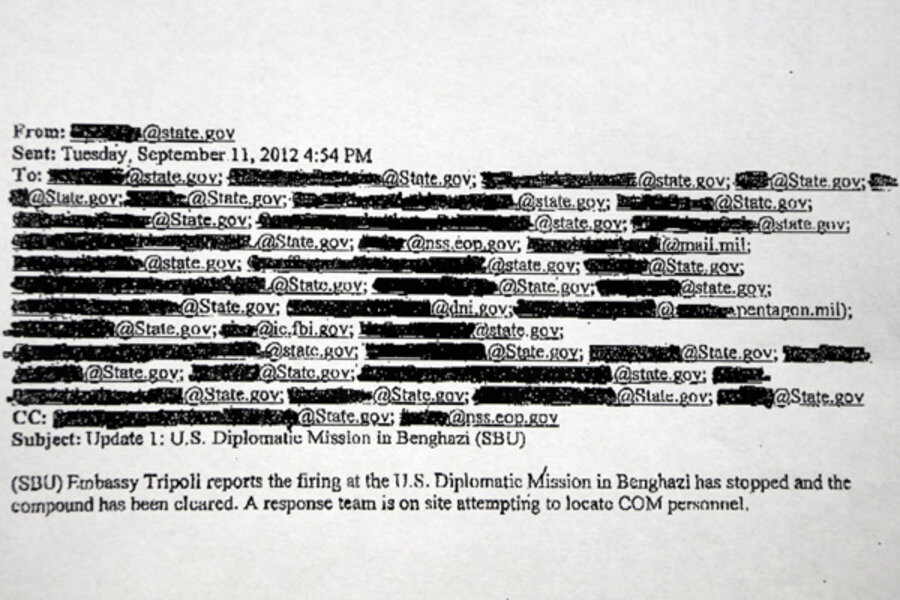Benghazi e-mails: What did Obama administration know when?
Loading...
| Washington
Newly disclosed e-mails show that the State Department and other federal agencies knew within hours of the attack on the US Consulate in Benghazi, Libya, that a local militant Islamist group was claiming responsibility for the action.
The State Department e-mails do not offer information that is markedly different from what was already known. Press reports the day after the Sept. 11 attack were already speculating about the involvement of Ansar al-Sharia, a Libyan extremist group with loose ties to Al Qaeda.
But they could nevertheless rekindle the controversy over what the Obama administration knew about the terrorist attack, when it knew it, and why administration officials persisted in speaking of a mob incited by an anti-Islam video as a perpetrator of the attack.
The attack on the Benghazi consulate resulted in the deaths of four US diplomats, including the ambassador to Libya, Christopher Stevens.
Secretary of State Hillary Rodham Clinton on Wednesday said that the e-mails, sent from the department’s operations center, were citing a claim of responsibility posted on Facebook, something she said “is not in and of itself evidence.” Instead of “cherry-picking one story here or one document there,” she said, it is important to consider the whole picture and take into account all information before making any judgments.
Terrorist organizations sometimes claim acts they had nothing to do with in an effort to build their credentials. On the other hand, terrorists sometimes also refrain from claiming their work.
In the case of Ansar al-Sharia, there is some indication from communications picked up by US intelligence services that the group boasted of its role in the consulate attack in its contacts with operatives for Al Qaeda in the Islamic Maghreb. In any case, Ansar al-Sharia representatives have since publicly denied any involvement in the attack.
One e-mail sent out two hours after the attack said that the US Embassy in Tripoli was reporting Ansar al-Sharia’s claim of responsibility and that the group was calling on Facebook and Twitter for an attack on that embassy.
Another e-mail speaks of a group of about 20 men firing shots and setting off explosions. In another, US Embassy Tripoli reports that firing had stopped and that the Benghazi compound was cleared.
In the confusion of the attack, Ambassador Stevens became separated from others at the consulate. His body was later found to be at a local hospital, where hospital workers used a cellphone in one of his pockets to try to determine the man’s identity.
White House spokesman Jay Carney, traveling Wednesday with President Obama, said the released e-mails were part of “all sorts of information that was becoming available in the aftermath of the attack.”
The attack is the subject of a State Department investigation launched by Secretary Clinton, as well as of separate inquiries taking place in the House and Senate.
Both Mr. Obama and the US ambassador to the United Nations, Susan Rice, have come under attack from Republicans for claiming days after the attack that the deadly assault began as a demonstration inspired by anti-US demonstrations elsewhere over the anti-Islam video. CIA documents released recently reveal that Obama and Ambassador Rice were describing what happened according to the information the Central Intelligence Agency was providing at the time.
Some militants in Benghazi who claim to have been involved in the attack have since told journalists that they were watching the demonstrations taking place the same day in Egypt and Tunisia in reaction to the anti-Islam video, and they decided to strike the consulate.






